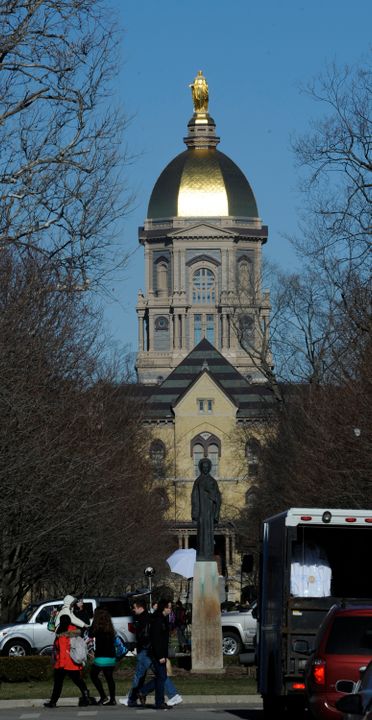Oct. 24, 2013
For the eighth time in nine years, the University of Notre Dame ranks number one on a percentage basis in terms of number of Graduation Success Rate (GSR) 100 scores, among all NCAA Football Bowl Subdivision schools.
Twenty of 22 athletics programs at Notre Dame compiled graduation rates of 100 percent, and none were below 93 percent, according to the ninth year of GSR measurements developed by the NCAA and released today. It’s the first time Notre Dame’s programs have combined for 20 perfect scores-after four previous years with 19.
None of the Football Bowl Subdivision (formerly NCAA Division I-A) programs in the country had a higher percentage of 100 GSR scores than did Notre Dame with its .909 number (20 of 22).
In addition, Notre Dame ranked second among all FBS institutions with nine perfect scores among 22 sports (.409) in the federal graduation rate analysis.
Here are the top institutions in the GSR category (these are the only FBS institutions with 50 or more percent of their sports registering 100 marks):
Graduation Success Rate
| Institution | Percentage | 100 Scores/Sports Rated |
| 1. Notre Dame | .909 | 20/22 |
| 2. Duke | .773 | 17/22 |
| 3. Stanford | .704 | 19/27 |
| 4. Vanderbilt | .692 | 9/13 |
| 5. Wake Forest | .643 | 9/14 |
| 6. Northwestern | .631 | 12/19 |
| 7. Boston College | .583 | 14/24 |
| 8. Miami (Fla.) | .571 | 8/14 |
Here are the top institutions in the federal category (these are the only seven FBS institutions with four or more 100 scores):
Federal Graduation Rates
| Institution | Percentage | 100 Scores/Sports Rated |
| 1. Stanford | .481 | 13/27 |
| 2. Notre Dame | .409 | 9/22 |
| 3. Northwestern | .316 | 6/19 |
| 4. Duke | .294 | 5/17 |
| 5. Boston College | .222 | 4/18 |
| 6. UCLA | .200 | 4/20 |
| 7. Michigan | .174 | 4/23 |
NCAA figures released today showed that all 11 Irish women’s programs posted a GSR of 100 percent–basketball, cross country/track, fencing, golf, lacrosse, rowing, soccer, softball, swimming/diving, tennis and volleyball. Among Notre Dame’s men’s sports, baseball, basketball, cross country/track, fencing, golf, hockey, soccer, swimming/diving and tennis achieved 100 percent GSR scores. Men’s lacrosse scored 96, and football came in at 93.
Overall, those 20 scores of 100 are one more than the number of perfect GSR scores from 2012, 2010, 2009 and 2008 (all four of those years with 19 of 22 sports at 100) for the Irish programs.
In the federal calculations, the nine Notre Dame programs with 100 scores were men’s fencing, men’s golf, men’s hockey, men’s tennis, women’s rowing, women’s golf, women’s lacrosse, women’s tennis and women’s volleyball. Other top Notre Dame programs in the federal analysis included men’s swimming at 95, both men’s and women’s cross country/track and field along with women’s soccer at 94, plus women’s swimming and men’s lacrosse at 93.
Here are other previous finishes for Notre Dame in terms of the GSR numbers:
- In 2011 and 2007, Notre Dame ranked number one with 18 of its 22 sports recording 100 scores (.818).
- In 2005, Notre Dame had the highest percentage of its sports with 100 percent scores with a .800 figure (16 of 20).
- The 2006 data put Notre Dame’s percentage at .773 (17 of 22), to rank second behind the U.S. Naval Academy.
The GSR data show the percentage of student-athletes earning a degree within six years. The NCAA developed the GSR to account for transfer student-athletes, midyear enrollees and others not tracked by the federal graduation rate. The GSR captures about 37 percent more students than the federal rate, resulting in a more accurate assessment of the academic success of student-athletes. However, the federal rate provides the only method by which student-athletes can be compared with the general student body. College and university presidents had asked the NCAA to develop a new methodology that takes into account the mobility among students in today’s higher education environment. Research indicates that approximately 60 percent of all new bachelor’s degree recipients are attending more than one undergraduate institution during their collegiate careers. The 2013 GSR numbers are based on entering classes from 2003 to 2006. The 2012 GSR numbers are based on entering classes from 2002 to 2005. The 2011 GSR numbers are based on entering classes from 2001 to 2004. The 2010 GSR numbers are based on entering classes from 2000 to 2003. The 2009 GSR numbers are based on entering classes from 1999 to 2002. The 2008 GSR numbers are based on entering classes from 1998 to 2001, the ’07 data on classes from 1997 to 2000, the ’06 data on classes from 1996 to 1999–and the ’05 first-year GSR data was based upon the classes entering from 1995 to 1998.
The GSR should not be confused with another NCAA initiative, the Academic Progress Rate, which uses a series of formulas related to student-athlete retention and eligibility to measure the academic performance of all participants who receive a grant-in-aid on every team at every NCAA Division I college and university. In addition to the GSR, the NCAA continues to compile data and release results based upon the federally mandated methodology.







